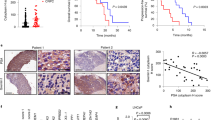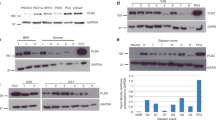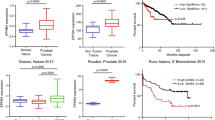Abstract
Enhanced RAS signaling and decreased androgen dependence of prostate cancer cells accompany poor clinical outcomes. Elevated autocrine fibroblast growth factors 2 (FGF-2) signaling promotes prostate cancer cell growth and survival. Expression of lysyl oxidase (LOX) inhibits RAS transforming activity. LOX is secreted as 50 kDa pro-LOX protein and then undergoes extracellular proteolytic processing to form ∼30 kDa LOX enzyme and ∼18 kDa propeptide (LOX-PP). We have previously shown that LOX-PP inhibits breast cancer cell transformation and tumor formation, but mechanisms of action of LOX-PP have not been fully elucidated. Here we report that LOX expression is reduced in prostate cancer cell lines and that recombinant LOX-PP protein inhibits serum-stimulated DNA synthesis and MEK/ERK and PI3K/AKT pathways in DU 145 and PC-3 androgen-independent cell lines. In DU 145 cells, treatment with a pharmacologic FGF-receptor inhibitor or a neutralizing anti-FGFR1 antibody mimicked LOX-PP inhibition of serum-stimulated DNA synthesis. FGF-2-stimulated DNA synthesis, ERK1/2, AKT and FRS2α activation were found all to be inhibited by LOX-PP in DU 145 cells. LOX-PP reduced specific binding of FGF-2 to DU 145 cells, suggesting that LOX-PP targets FGF signaling at the receptor. Interestingly, PC-3 cells did not respond to FGF-2, consistent with previous reports. We conclude that LOX-PP inhibits proliferation of DU 145 cells by interfering with FGFR(s) binding and signaling, and that LOX-PP has other mechanisms of action in PC-3 cells.
This is a preview of subscription content, access via your institution
Access options
Subscribe to this journal
Receive 50 print issues and online access
$259.00 per year
only $5.18 per issue
Buy this article
- Purchase on Springer Link
- Instant access to full article PDF
Prices may be subject to local taxes which are calculated during checkout











Similar content being viewed by others
References
Bansal R, Magge S, Winkler S . (2003). Specific inhibitor of FGF receptor signaling: FGF-2-mediated effects on proliferation, differentiation, and MAPK activation are inhibited by PD173074 in oligodendrocyte-lineage cells. J Neurosci Res 74: 486–493.
Blanckaert VD, Venkateswaran S, Han IS, Kim KH, Griswold MD, Schelling ME . (2002). Partial characterization of endothelial FGF receptor functional domain by monoclonal antibody VBS-1. Hybrid Hybridomics 21: 153–159.
Bonaccorsi L, Marchiani S, Muratori M, Forti G, Baldi E . (2004). Gefitinib (‘IRESSA’, ZD1839) inhibits EGF-induced invasion in prostate cancer cells by suppressing PI3K/AKT activation. J Cancer Res Clin Oncol 130: 604–614.
Chu CL, Buczek-Thomas JA, Nugent MA . (2004). Heparan sulphate proteoglycans modulate fibroblast growth factor-2 binding through a lipid raft-mediated mechanism. Biochem J 379: 331–341.
Chua CC, Rahimi N, Forsten-Williams K, Nugent MA . (2004). Heparan sulfate proteoglycans function as receptors for fibroblast growth factor-2 activation of extracellular signal-regulated kinases 1 and 2. Circ Res 94: 316–323.
Contente S, Kenyon K, Rimoldi D, Friedman RM . (1990). Expression of gene rrg is associated with reversion of NIH 3T3 transformed by LTR-c-H-ras. Science 249: 796–798.
Contente S, Yeh TJ, Friedman RM . (2009). Tumor suppressive effect of lysyl oxidase proenzyme. Biochim Biophys Acta 1793: 1272–1278.
Cronauer MV, Hittmair A, Eder IE, Hobisch A, Culig Z, Ramoner R et al. (1997). Basic fibroblast growth factor levels in cancer cells and in sera of patients suffering from proliferative disorders of the prostate. Prostate 31: 223–233.
Culig Z, Hobisch A, Cronauer MV, Radmayr C, Trapman J, Hittmair A et al. (1994). Androgen receptor activation in prostatic tumor cell lines by insulin-like growth factor-I, keratinocyte growth factor, and epidermal growth factor. Cancer Res 54: 5474–5478.
Erler JT, Bennewith KL, Cox TR, Lang G, Bird D, Koong A et al. (2009). Hypoxia-induced lysyl oxidase is a critical mediator of bone marrow cell recruitment to form the premetastatic niche. Cancer Cell 15: 35–44.
Erler JT, Bennewith KL, Nicolau M, Dornhofer N, Kong C, Le QT et al. (2006). Lysyl oxidase is essential for hypoxia-induced metastasis. Nature 440: 1222–1226.
Erler JT, Giaccia AJ . (2006). Lysyl oxidase mediates hypoxic control of metastasis. Cancer Res 66: 10238–10241.
Erler JT, Weaver VM . (2009). Three-dimensional context regulation of metastasis. Clin Exp Metastasis 26: 35–49.
Erlich S, Tal-Or P, Liebling R, Blum R, Karunagaran D, Kloog Y et al. (2006). Ras inhibition results in growth arrest and death of androgen-dependent and androgen-independent prostate cancer cells. Biochem Pharmacol 72: 427–436.
Eswarakumar VP, Lax I, Schlessinger J . (2005). Cellular signaling by fibroblast growth factor receptors. Cytokine Growth Factor Rev 16: 139–149.
Fannon M, Nugent MA . (1996). Basic fibroblast growth factor binds its receptors, is internalized, and stimulates DNA synthesis in Balb/c3T3 cells in the absence of heparan sulfate. J Biol Chem 271: 17949–17956.
Forsten-Williams K, Chua CC, Nugent MA . (2005). The kinetics of FGF-2 binding to heparan sulfate proteoglycans and MAP kinase signaling. J Theor Biol 233: 483–499.
Gioeli D . (2005). Signal transduction in prostate cancer progression. Clin Sci (Lond) 108: 293–308.
Gioeli D, Mandell JW, Petroni GR, Frierson Jr HF, Weber MJ . (1999). Activation of mitogen-activated protein kinase associated with prostate cancer progression. Cancer Res 59: 279–284.
Giri D, Ozen M, Ittmann M . (2001). Interleukin-6 is an autocrine growth factor in human prostate cancer. Am J Pathol 159: 2159–2165.
Giri D, Ropiquet F, Ittmann M . (1999). Alterations in expression of basic fibroblast growth factor (FGF) 2 and its receptor FGFR-1 in human prostate cancer. Clin Cancer Res 5: 1063–1071.
Guo Y, Pischon N, Palamakumbura AH, Trackman PC . (2007). Intracellular distribution of the lysyl oxidase propeptide in osteoblastic cells. Am J Physiol Cell Physiol 292: C2095–C2102.
Hajnal A, Klemenz R, Schafer R . (1993). Up-regulation of lysyl oxidase in spontaneous revertants of H-ras-transformed rat fibroblasts. Cancer Res 53: 4670–4675.
Hamalainen ER, Kemppainen R, Kuivaniemi H, Tromp G, Vaheri A, Pihlajaniemi T et al. (1995). Quantitative polymerase chain reaction of lysyl oxidase mRNA in malignantly transformed human cell lines demonstrates that their low lysyl oxidase activity is due to low quantities of its mRNA and low levels of transcription of the respective gene. J Biol Chem 270: 21590–21593.
Hatziapostolou M, Polytarchou C, Katsoris P, Courty J, Papadimitriou E . (2006). Heparin affin regulatory peptide/pleiotrophin mediates fibroblast growth factor 2 stimulatory effects on human prostate cancer cells. J Biol Chem 281: 32217–32226.
He QM, Wei YQ, Tian L, Zhao X, Su JM, Yang L et al. (2003). Inhibition of tumor growth with a vaccine based on xenogeneic homologous fibroblast growth factor receptor-1 in mice. J Biol Chem 278: 21831–21836.
Huggett J, Dheda K, Bustin S, Zumla A . (2005). Real-time RT-PCR normalisation; strategies and considerations. Genes Immun 6: 279–284.
Hurtado PA, Vora S, Sume SS, Yang D, St Hilaire C, Guo Y et al. (2008). Lysyl oxidase propeptide inhibits smooth muscle cell signaling and proliferation. Biochem Biophys Res Commun 366: 156–161.
Jeay S, Pianetti S, Kagan HM, Sonenshein GE . (2003). Lysyl oxidase inhibits ras-mediated transformation by preventing activation of NF-kappa B. Mol Cell Biol 23: 2251–2263.
Johnson DE, Williams LT . (1993). Structural and functional diversity in the FGF receptor multigene family. Adv Cancer Res 60: 1–41.
Jones HE, Dutkowski CM, Barrow D, Harper ME, Wakeling AE, Nicholson RI . (1997). New EGF-R selective tyrosine kinase inhibitor reveals variable growth responses in prostate carcinoma cell lines PC-3 and DU-145. Int J Cancer 71: 1010–1018.
Kagan HM, Li W . (2003). Lysyl oxidase: properties, specificity, and biological roles inside and outside of the cell. J Cell Biochem 88: 660–672.
Kagan HM, Trackman PC . (1991). Properties and function of lysyl oxidase. Am J Respir Cell Mol Biol 5: 206–210.
Kenyon K, Contente S, Trackman PC, Tang J, Kagan HM, Friedman RM . (1991). Lysyl oxidase and rrg messenger RNA. Science 253: 802.
Kirschmann DA, Seftor EA, Fong SF, Nieva DR, Sullivan CM, Edwards EM et al. (2002). A molecular role for lysyl oxidase in breast cancer invasion. Cancer Res 62: 4478–4483.
Kominsky SL, Hobeika AC, Lake FA, Torres BA, Johnson HM . (2000). Down-regulation of neu/HER-2 by interferon-gamma in prostate cancer cells. Cancer Res 60: 3904–3908.
Krzyzosiak WJ, Shindo-Okada N, Teshima H, Nakajima K, Nishimura S . (1992). Isolation of genes specifically expressed in flat revertant cells derived from activated ras-transformed NIH 3T3 cells by treatment with azatyrosine. Proc Natl Acad Sci USA 89: 4879–4883.
Kuivaniemi H, Korhonen RM, Vaheri A, Kivirikko KI . (1986). Deficient production of lysyl oxidase in cultures of malignantly transformed human cells. FEBS Lett 195: 261–264.
Kwabi-Addo B, Ozen M, Ittmann M . (2004). The role of fibroblast growth factors and their receptors in prostate cancer. Endocr Relat Cancer 11: 709–724.
McPherson RA, Conaway MC, Gregory CW, Yue W, Santen RJ . (2004). The novel Ras antagonist, farnesylthiosalicylate, suppresses growth of prostate cancer in vitro. Prostate 58: 325–334.
Min C, Kirsch KH, Zhao Y, Jeay S, Palamakumbura AH, Trackman PC et al. (2007). The tumor suppressor activity of the lysyl oxidase propeptide reverses the invasive phenotype of Her-2/neu-driven breast cancer. Cancer Res 67: 1105–1112.
Mohammadi M, Honegger AM, Rotin D, Fischer R, Bellot F, Li W et al. (1991). A tyrosine-phosphorylated carboxy-terminal peptide of the fibroblast growth factor receptor (Flg) is a binding site for the SH2 domain of phospholipase C-gamma 1. Mol Cell Biol 11: 5068–5078.
Mohammadi M, McMahon G, Sun L, Tang C, Hirth P, Yeh BK et al. (1997). Structures of the tyrosine kinase domain of fibroblast growth factor receptor in complex with inhibitors. Science 276: 955–960.
Nakamoto T, Chang CS, Li AK, Chodak GW . (1992). Basic fibroblast growth factor in human prostate cancer cells. Cancer Res 52: 571–577.
Natke B, Venkataraman G, Nugent MA, Sasisekharan R . (1999). Heparinase treatment of bovine smooth muscle cells inhibits fibroblast growth factor-2 binding to fibroblast growth factor receptor but not FGF-2 mediated cellular proliferation. Angiogenesis 3: 249–257.
Nissen LJ, Cao R, Hedlund EM, Wang Z, Zhao X, Wetterskog D et al. (2007). Angiogenic factors FGF2 and PDGF-BB synergistically promote murine tumor neovascularization and metastasis. J Clin Invest 117: 2766–2777.
Nugent MA, Edelman ER . (1992). Kinetics of basic fibroblast growth factor binding to its receptor and heparan sulfate proteoglycan: a mechanism for cooperactivity. Biochemistry 31: 8876–8883.
Nugent MA, Iozzo RV . (2000). Fibroblast growth factor-2. Int J Biochem Cell Biol 32: 115–120.
Ozen M, Giri D, Ropiquet F, Mansukhani A, Ittmann M . (2001). Role of fibroblast growth factor receptor signaling in prostate cancer cell survival. J Natl Cancer Inst 93: 1783–1790.
Palamakumbura AH, Jeay S, Guo Y, Pischon N, Sommer P, Sonenshein GE et al. (2004). The propeptide domain of lysyl oxidase induces phenotypic reversion of ras-transformed cells. J Biol Chem 279: 40593–40600.
Palamakumbura AH, Sommer P, Trackman PC . (2003). Autocrine growth factor regulation of lysyl oxidase expression in transformed fibroblasts. J Biol Chem 278: 30781–30787.
Payne SL, Fogelgren B, Hess AR, Seftor EA, Wiley EL, Fong SF et al. (2005). Lysyl oxidase regulates breast cancer cell migration and adhesion through a hydrogen peroxide-mediated mechanism. Cancer Res 65: 11429–11436.
Planz B, Wang Q, Kirley SD, Marberger M, McDougal WS . (2001). Regulation of keratinocyte growth factor receptor and androgen receptor in epithelial cells of the human prostate. J Urol 166: 678–683.
Polnaszek N, Kwabi-Addo B, Peterson LE, Ozen M, Greenberg NM, Ortega S et al. (2003). Fibroblast growth factor 2 promotes tumor progression in an autochthonous mouse model of prostate cancer. Cancer Res 63: 5754–5760.
Powers CJ, McLeskey SW, Wellstein A . (2000). Fibroblast growth factors, their receptors and signaling. Endocr Relat Cancer 7: 165–197.
Ren C, Yang G, Timme TL, Wheeler TM, Thompson TC . (1998). Reduced lysyl oxidase messenger RNA levels in experimental and human prostate cancer. Cancer Res 58: 1285–1290.
Richardson TP, Trinkaus-Randall V, Nugent MA . (1999). Regulation of basic fibroblast growth factor binding and activity by cell density and heparan sulfate. J Biol Chem 274: 13534–13540.
Ropiquet F, Giri D, Kwabi-Addo B, Mansukhani A, Ittmann M . (2000). Increased expression of fibroblast growth factor 6 in human prostatic intraepithelial neoplasia and prostate cancer. Cancer Res 60: 4245–4250.
Ropiquet F, Giri D, Lamb DJ, Ittmann M . (1999). FGF7 and FGF2 are increased in benign prostatic hyperplasia and are associated with increased proliferation. J Urol 162: 595–599.
Samid D, Shack S, Myers CE . (1993). Selective growth arrest and phenotypic reversion of prostate cancer cells in vitro by nontoxic pharmacological concentrations of phenylacetate. J Clin Invest 91: 2288–2295.
Schlessinger J . (2004). Common and distinct elements in cellular signaling via EGF and FGF receptors. Science 306: 1506–1507.
Shain SA . (2004). Exogenous fibroblast growth factors maintain viability, promote proliferation, and suppress GADD45alpha and GAS6 transcript content of prostate cancer cells genetically modified to lack endogenous FGF-2. Mol Cancer Res 2: 653–661.
Smith JA, Madden T, Vijjeswarapu M, Newman RA . (2001). Inhibition of export of fibroblast growth factor-2 (FGF-2) from the prostate cancer cell lines PC3 and DU145 by Anvirzel and its cardiac glycoside component, oleandrin. Biochem Pharmacol 62: 469–472.
Trackman PC, Bedell-Hogan D, Tang J, Kagan HM . (1992). Post-translational glycosylation and proteolytic processing of a lysyl oxidase precursor. J Biol Chem 267: 8666–8671.
Uzel MI, Scott IC, Babakhanlou-Chase H, Palamakumbura AH, Pappano WN, Hong HH et al. (2001). Multiple bone morphogenetic protein 1-related mammalian metalloproteinases process pro-lysyl oxidase at the correct physiological site and control lysyl oxidase activation in mouse embryo fibroblast cultures. J Biol Chem 276: 22537–22543.
Weber MJ, Gioeli D . (2004). Ras signaling in prostate cancer progression. J Cell Biochem 91: 13–25.
Wesley UV, McGroarty M, Homoyouni A . (2005). Dipeptidyl peptidase inhibits malignant phenotype of prostate cancer cells by blocking basic fibroblast growth factor signaling pathway. Cancer Res 65: 1325–1334.
Wu M, Min C, Wang X, Yu Z, Kirsch KH, Trackman PC et al. (2007). Repression of BCL2 by the tumor suppressor activity of the lysyl oxidase propeptide inhibits transformed phenotype of lung and pancreatic cancer cells. Cancer Res 67: 6278–6285.
Zhang Y, Song S, Yang F, Au JL, Wientjes MG . (2001). Nontoxic doses of suramin enhance activity of doxorubicin in prostate tumors. J Pharmacol Exp Ther 299: 426–433.
Zhao Y, Min C, Vora SR, Trackman PC, Sonenshein GE, Kirsch KH . (2009). The lysyl oxidase pro-peptide attenuates fibronectin-mediated activation of focal adhesion kinase and p130Cas in breast cancer cells. J Biol Chem 284: 1385–1393.
Acknowledgements
This study was supported by NIH/NCI CA082742, DOD Award W81XWH-08-1-0349, NIH/NIDCR DE14066. We thank Danielle Stephens and Emilie Vu for expert preparation of rLOX-PP.
Author information
Authors and Affiliations
Corresponding author
Additional information
Supplementary Information accompanies the paper on the Oncogene website (http://www.nature.com/onc)
Supplementary information
Rights and permissions
About this article
Cite this article
Palamakumbura, A., Vora, S., Nugent, M. et al. Lysyl oxidase propeptide inhibits prostate cancer cell growth by mechanisms that target FGF-2-cell binding and signaling. Oncogene 28, 3390–3400 (2009). https://doi.org/10.1038/onc.2009.203
Received:
Revised:
Accepted:
Published:
Issue Date:
DOI: https://doi.org/10.1038/onc.2009.203
Keywords
This article is cited by
-
LOXL1 modulates the malignant progression of colorectal cancer by inhibiting the transcriptional activity of YAP
Cell Communication and Signaling (2020)
-
Involvement of miR-30b in kynurenine-mediated lysyl oxidase expression
Journal of Physiology and Biochemistry (2019)
-
Inhibition of angiogenesis in endothelial cells by Human Lysyl oxidase propeptide
Scientific Reports (2018)
-
Functional importance of lysyl oxidase family propeptide regions
Journal of Cell Communication and Signaling (2018)
-
Inhibition of Lysyl Oxidase and Lysyl Oxidase-Like Enzymes Has Tumour-Promoting and Tumour-Suppressing Roles in Experimental Prostate Cancer
Scientific Reports (2016)



